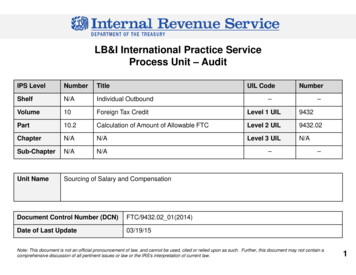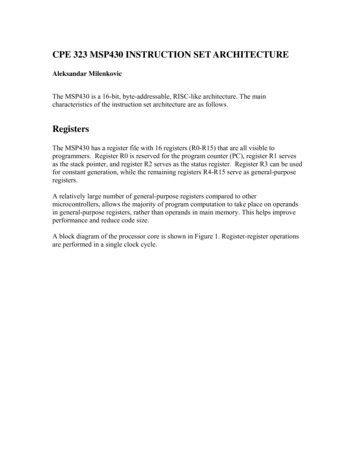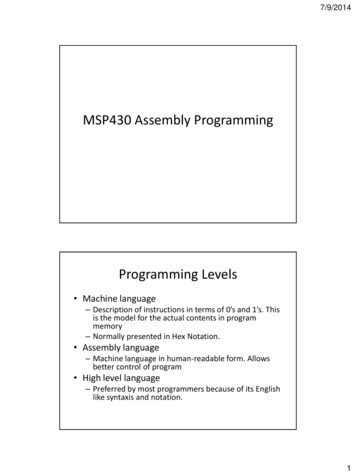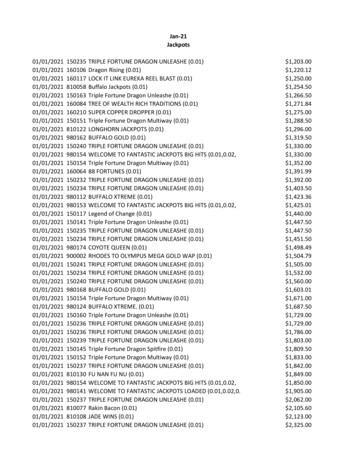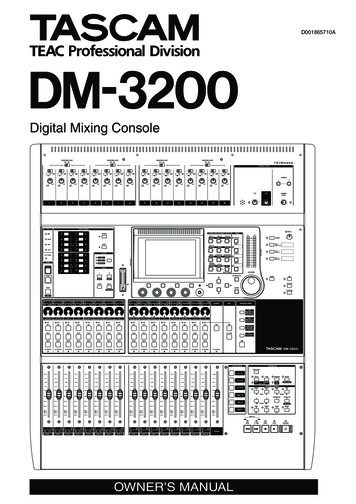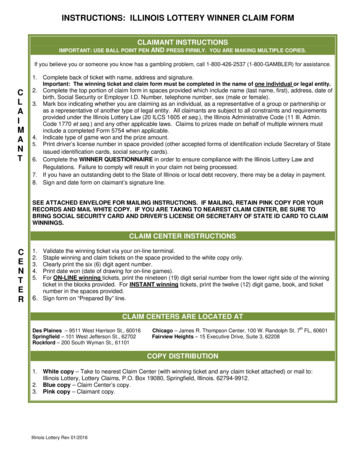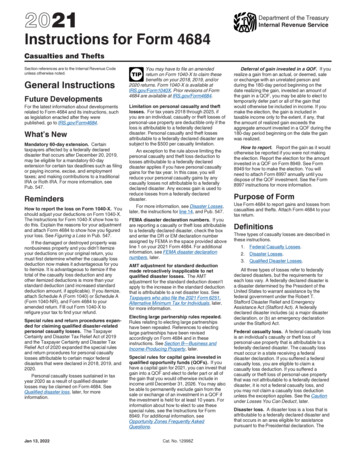
Transcription
2021Department of the TreasuryInternal Revenue ServiceInstructions for Form 4684Casualties and TheftsSection references are to the Internal Revenue Codeunless otherwise noted.General InstructionsFuture DevelopmentsFor the latest information about developmentsrelated to Form 4684 and its instructions, suchas legislation enacted after they werepublished, go to IRS.gov/Form4684.What’s NewMandatory 60-day extension. Certaintaxpayers affected by a federally declareddisaster that occurs after December 20, 2019,may be eligible for a mandatory 60-dayextension for certain tax deadlines such as filingor paying income, excise, and employmenttaxes; and making contributions to a traditionalIRA or Roth IRA. For more information, seePub. 547.RemindersHow to report the loss on Form 1040-X. Youshould adjust your deductions on Form 1040-X.The Instructions for Form 1040-X show how todo this. Explain the reasons for your adjustmentand attach Form 4684 to show how you figuredyour loss. See Figuring a Loss in Pub. 547.If the damaged or destroyed property wasnonbusiness property and you didn’t itemizeyour deductions on your original return, youmust first determine whether the casualty lossdeduction now makes it advantageous for youto itemize. It is advantageous to itemize if thetotal of the casualty loss deduction and anyother itemized deductions is more than yourstandard deduction (and increased standarddeduction amount, if applicable). If you itemize,attach Schedule A (Form 1040) or Schedule A(Form 1040-NR), and Form 4684 to youramended return. Fill out Form 1040-X torefigure your tax to find your refund.Special rules and return procedures expanded for claiming qualified disaster-relatedpersonal casualty losses. The TaxpayerCertainty and Disaster Tax Relief Act of 2019and the Taxpayer Certainty and Disaster TaxRelief Act of 2020 expanded the special rulesand return procedures for personal casualtylosses attributable to certain major federaldisasters that were declared in 2018, 2019, and2020.Personal casualty losses sustained in taxyear 2020 as a result of qualified disasterlosses may be claimed on Form 4684. SeeQualified disaster loss, later, for moreinformation.Jan 13, 2022You may have to file an amendedTIP return on Form 1040-X to claim thesebenefits on your 2018, 2019, and/or2020 returns. Form 1040-X is available atIRS.gov/Form1040X. Prior revisions of Form4684 are available at IRS.gov/Form4684.Limitation on personal casualty and theftlosses. For tax years 2018 through 2025, ifyou are an individual, casualty or theft losses ofpersonal-use property are deductible only if theloss is attributable to a federally declareddisaster. Personal casualty and theft lossesattributable to a federally declared disaster aresubject to the 500 per casualty limitation.An exception to the rule above limiting thepersonal casualty and theft loss deduction tolosses attributable to a federally declareddisaster applies if you have personal casualtygains for the tax year. In this case, you willreduce your personal casualty gains by anycasualty losses not attributable to a federallydeclared disaster. Any excess gain is used toreduce losses from a federally declareddisaster.For more information, see Disaster Losses,later, the instructions for line 14, and Pub. 547.FEMA disaster declaration numbers. If youare reporting a casualty or theft loss attributableto a federally declared disaster, check the boxand enter the DR or EM declaration numberassigned by FEMA in the space provided aboveline 1 on your 2021 Form 4684. For additionalinformation, see FEMA disaster declarationnumbers, later.AMT adjustment for standard deductionmade retroactively inapplicable to netqualified disaster losses. The AMTadjustment for the standard deduction doesn'tapply to the increase in the standard deductionthat is attributable to a net disaster loss. SeeTaxpayers who also file the 2021 Form 6251,Alternative Minimum Tax for Individuals, later,for more information.Electing large partnership rules repealed.Rules relating to electing large partnershipshave been repealed. References to electinglarge partnerships have been revisedaccordingly on Form 4684 and in theseinstructions. See Section B—Business andIncome-Producing Property, later.Special rules for capital gains invested inqualified opportunity funds (QOFs). If youhave a capital gain for 2021, you can invest thatgain into a QOF and elect to defer part or all ofthe gain that you would otherwise include inincome until December 31, 2026. You may alsobe able to permanently exclude gain from thesale or exchange of an investment in a QOF ifthe investment is held for at least 10 years. Forinformation about how to elect to use thesespecial rules, see the Instructions for Form8949. For additional information, seeOpportunity Zones Frequently AskedQuestions.Cat. No. 12998ZDeferral of gain invested in a QOF. If yourealize a gain from an actual, or deemed, saleor exchange with an unrelated person andduring the 180-day period beginning on thedate realizing the gain, invested an amount ofthe gain in a QOF, you may be able to elect totemporarily defer part or all of the gain thatwould otherwise be included in income. If youmake the election, the gain is included intaxable income only to the extent, if any, thatthe amount of realized gain exceeds theaggregate amount invested in a QOF during the180-day period beginning on the date the gainwas realized.How to report. Report the gain as it wouldotherwise be reported if you were not makingthe election. Report the election for the amountinvested in a QOF on Form 8949. See Form8949 for how to make the election. You willneed to attach Form 8997 annually until youdispose of the QOF investment. See the Form8997 instructions for more information.Purpose of FormUse Form 4684 to report gains and losses fromcasualties and thefts. Attach Form 4684 to yourtax return.DefinitionsThree types of casualty losses are described inthese instructions.1.Federal Casualty Losses.2.Disaster Losses.3.Qualified Disaster Losses.All three types of losses refer to federallydeclared disasters, but the requirements foreach loss vary. A federally declared disaster isa disaster determined by the President of theUnited States to warrant assistance by thefederal government under the Robert T.Stafford Disaster Relief and EmergencyAssistance Act (Stafford Act). A federallydeclared disaster includes (a) a major disasterdeclaration, or (b) an emergency declarationunder the Stafford Act.Federal casualty loss. A federal casualty lossis an individual’s casualty or theft loss ofpersonal-use property that is attributable to afederally declared disaster. The casualty lossmust occur in a state receiving a federaldisaster declaration. If you suffered a federalcasualty loss, you are eligible to claim acasualty loss deduction. If you suffered acasualty or theft loss of personal-use propertythat was not attributable to a federally declareddisaster, it is not a federal casualty loss, andyou may not claim a casualty loss deductionunless the exception applies. See the Cautionunder Losses You Can Deduct, later.Disaster loss. A disaster loss is a loss that isattributable to a federally declared disaster andthat occurs in an area eligible for assistancepursuant to the Presidential declaration. The
disaster loss must occur in a county eligible forpublic or individual assistance (or both).Disaster losses are not limited to individualpersonal-use property and may be claimed forindividual business or income-producingproperty and by corporations, S corporations,and partnerships. If you suffered a disaster loss,you are eligible to claim a casualty lossdeduction and to elect to claim the loss in thepreceding tax year. See Disaster Losses, later.Qualified disaster loss. A qualified disasterloss also includes an individual's casualty ortheft loss of personal-use property that isattributable to: A major disaster declared by the Presidentunder section 401 of the Stafford Act in 2016; Hurricane Harvey; Tropical Storm Harvey; Hurricane Irma; Hurricane Maria; The California wildfires in 2017 and January2018; A major disaster that was declared by thePresident under section 401 of the Stafford Actand that occurred in 2018 and beforeDecember 21, 2019, and continued no laterthan January 19, 2020 (except thoseattributable to the California wildfires in January2018 that received prior relief); and A major disaster that was declared byPresidential Declaration that is dated betweenJanuary 1, 2020, and February 25, 2021(inclusive). However, in order to qualify underthis expansion, the major disaster must have anincident period beginning between December28, 2019, and December 27, 2020 (inclusive).Further, the major disaster must have anincident period ending no later than January 26,2021. However, this change does not includethose losses attributable to any major disasterwhich has been declared only by reason ofCOVID-19.If you suffered a qualified disaster loss, youare eligible to claim a casualty loss deduction,to elect to claim the loss in the preceding taxyear, and to deduct the loss without itemizingother deductions on Schedule A (Form 1040).See Qualified disaster losses and Increasedstandard deduction reporting, later.See also IRS.gov/DisasterTaxRelief fordate-specific declarations associated withthese disasters and for more information.Losses You Can DeductFor tax years 2018 through 2025, if you are anindividual, losses of personal-use property fromfire, storm, shipwreck, or other casualty, or theftare deductible only if the loss is attributable to afederally declared disaster (federal casualtyloss). See Pub. 547 for more information.If the event causing you to suffer a personalcasualty loss occurred before January 1, 2018,but the casualty loss was not sustained untilJanuary 1, 2018, or later, the casualty loss isnot deductible. See When To Deduct a Loss,later, for more information on when a casualtyloss is sustained.An exception to the rule limiting thededuction for personal casualty andCAUTION theft losses to federal casualty lossesapplies where you have personal casualty gainsto the extent the losses don’t exceed yourgains.!If your property is covered by insurance, andyour loss is otherwise deductible, you shouldfile a timely insurance claim for reimbursementof your loss. If you don't file a timely insuranceclaim, you can't deduct the full unrecoveredamount as a casualty or theft loss and only thepart of the loss that isn't covered by yourinsurance policy is deductible.Related expenses. The related expenses youhave due to a casualty or theft, such asexpenses for the treatment of personal injuriesor for the rental of a car, aren't deductible ascasualty or theft losses.Costs for protection against futurecasualties aren't deductible but should becapitalized as permanent improvements. Anexample would be the cost of a levee to stopflooding.Losses You Can't Deduct Money or property misplaced or lost. Breakage of china, glassware, furniture, andsimilar items under normal conditions. Progressive damage to property (buildings,clothes, trees, etc.) caused by termites, moths,other insects, or disease. See Pub. 547 forinformation on the treatment of deterioratingconcrete foundations that contain the mineralpyrrhotite. A decline in market value of stock, causedby disclosure of accounting or other illegalmisconduct by the officers or directors of thecorporation that issues the stock, that wasacquired on the open market for investment.You may be able to deduct it as a capital losson Schedule D (Form 1040) if the stock is soldor exchanged or becomes completelyworthless. See chapter 4 of Pub. 550,Investment Income and Expenses.Note. Victims of fraudulent investmentschemes can claim a theft loss deduction ifcertain conditions apply. See Losses FromPonzi-Type Investment Schemes, later, formore information.Gain on ReimbursementIf the amount you receive in insurance or otherreimbursement is more than the cost or otherbasis of the property, you have a gain. If youhave a gain, you may have to pay tax on it, oryou may be able to postpone the gain.Don't report the gain on damaged,destroyed, or stolen property if you receiveproperty that is similar or related to it in serviceor use. Your basis in the new property is thesame as your basis in the old property.Any tangible replacement property held foruse in a trade or business is treated as similaror related in service or use to property held foruse in a trade or business or for investment if: The property you are replacing wasdamaged or destroyed in a disaster, and The area in which the property wasdamaged or destroyed was declared by thePresident of the United States to warrantfederal assistance because of that disaster.Generally, you must recognize the gain ifyou receive unlike property or money asreimbursement. But you can generally chooseto postpone all or part of the gain if, within 2years of the end of the first tax year in whichany part of the gain is realized, you purchase:-2- Property similar or related in service or useto the damaged, destroyed, or stolen property;or A controlling interest (at least 80%) in acorporation owning such property.To postpone all of the gain, the cost of thereplacement property must be equal to or morethan the reimbursement you received for yourproperty. If the cost of the replacement propertyis less than the reimbursement received, youmust recognize the gain to the extent thereimbursement exceeds the cost of thereplacement property.If the replacement property or stock isacquired from a related person, gain generallycan't be postponed by: Corporations (other than S corporations); Partnerships in which more than 50% of thecapital or profits interest is owned bycorporations (other than S corporations); or All other taxpayers, unless the aggregaterealized gains on the involuntarily convertedproperty are 100,000 or less for the tax year.This rule applies to partnerships and Scorporations at both the entity and partner orshareholder level.For details on how to postpone the gain, seePub. 547.If your main home was located in a disasterarea and that home or any of its contents weredamaged or destroyed due to the disaster,special rules apply. See Gains Realized onHomes in Disaster Areas, later.When To Deduct a LossGenerally, you can deduct the part of yourcasualty or theft loss that isn't reimbursable inthe tax year the casualty occurred or the theftwas discovered. However, a disaster loss and aloss from deposits in insolvent or bankruptfinancial institutions may be treated differently.See Disaster Losses and Special Treatment forLosses on Deposits in Insolvent or BankruptFinancial Institutions, later.If in the year of the casualty there is a claimfor reimbursement with a reasonable prospectof recovery, the loss is not sustained until youknow with reasonable certainty whether suchreimbursement will be received. If you aren'tsure whether part of your casualty or theft losswill be reimbursed, don't deduct that part untilthe tax year when you become reasonablycertain that it won't be reimbursed. This later taxyear is when your loss is sustained.If you are reimbursed for a loss youdeducted in an earlier year, include thereimbursement in your income in the year youreceived it, but only to the extent the deductionreduced your tax in an earlier year.See Lessee's loss in Pub. 547 for specialrules on when to deduct losses from casualtiesand thefts to leased property.Disaster LossesA disaster loss is a loss that occurred in an areadetermined by the President of the UnitedStates to warrant federal disaster assistanceand that is attributable to a federally declareddisaster. It includes a major disaster oremergency declaration.Instructions for Form 4684 (2021)
For a list of federally declared disastersTIP and disaster areas, see FEMA.gov/Disasters.To determine the amount to deduct for adisaster loss, you must take into account asreimbursements any benefits you received orwhich you have a reasonable possibility ofreceiving from federal or state programs torestore your property.Disaster year. The disaster year is the taxyear in which you sustained the loss attributableto a federally declared disaster. Generally, adisaster loss is sustained in the year thedisaster occurred. However, a disaster lossmay also be sustained in a year after thedisaster occurred. For example, if a claim forreimbursement exists for which there is areasonable prospect of recovery, no part of theloss for which reimbursement may be receivedis sustained until it can be ascertained withreasonable certainty whether you will bereimbursed.Example. In December 2020, your car wasdestroyed in severe flooding that occurred inthe area where you live. The area where youlived was designated by the FederalEmergency Management Agency (FEMA) to beeligible for public or individual assistance (orboth). You immediately filed a claim forreimbursement with your insurance company.There was a reasonable prospect that youwould recover the full amount of your loss. Theclaim was settled in January 2021 when yourinsurance company reimbursed you for onlyhalf of your loss. The disaster year is 2021 (not2020 when the loss occurred). Your loss wassustained in 2021 because that’s when itbecame reasonably certain whether you wouldbe reimbursed. You can either deduct theunreimbursed loss on your tax return for thedisaster year (2021) or make an election todeduct the unreimbursed loss on your tax returnfor the preceding year (2020).If you realize a gain from thereimbursement on your casualty loss,CAUTION do not report the gain until the year inwhich that amount is received.!Election to deduct loss in the precedingyear. If you have a casualty loss from afederally declared disaster that occurred in anarea warranting public or individual assistance(or both), you can elect to deduct the loss in thetax year immediately before the disaster year. Alist of areas warranting public or individualassistance (or both) is available at the FEMAwebsite at FEMA.gov/Disasters.To make this election for a loss in disasteryear 2021, complete Part I of Section D on your2020 Form 4684 and attach it to your 2020original or amended return that claims thedisaster loss. See Section D—Election ToDeduct Federally Declared Disaster Loss inPreceding Tax Year, later.You must make an election to deduct a 2021disaster loss on your 2020 return on or beforethe date that is 6 months after the regular duedate for filing your original return (withoutextensions) for the disaster year. For calendaryear individual taxpayers, the deadline forelecting to take a 2021 disaster loss on your2020 tax return is October 15, 2022.Instructions for Form 4684 (2021)Revoking a prior election to deduct lossin the preceding year. Complete Part II ofSection D if you want to revoke a 2021 disasteryear election to deduct a federally declareddisaster loss in the preceding tax year. Attachthe completed Section D to an amended returnfor the preceding year (that is, to an amended2020 return for the revocation of a 2021disaster year election). SeeSection D—Election To Deduct FederallyDeclared Disaster Loss in Preceding Tax Year,later.for date-specific declarations associated withthese disasters and for more information.Your amended return eliminating theelection must be filed on or before the date thatis 90 days after the due date for making theelection and on or before the date you file anyreturn or amended return for the year thatincludes the disaster loss.Increased standard deduction reporting. Ifyou have a net qualified disaster loss and aren’titemizing your deductions, you can claim anincreased standard deduction usingSchedule A (Form 1040) or Schedule A (Form1040-NR), by doing the following.Your amended return (eliminating theprevious disaster loss election) should refigureyour tax liability as a result of revoking theelection. You must pay or make arrangementsto pay any tax and interest due as a result of therevocation.Home made unsafe by disaster. If yourhome was located in a disaster area and yourstate or local government ordered you to tear itdown or move it because it was no longer safeto use as a home due to the disaster, theresulting loss in value is treated as a disasterloss. The order for you to tear down or move thehome must have been issued within 120 daysafter the area was officially declared a disasterarea.For purposes of figuring the disaster loss,use the value of your home before you moved itor tore it down as its fair market value after thecasualty.Qualified disaster losses. A qualifieddisaster loss also includes an individual'scasualty or theft loss of personal-use propertythat is attributable to: A major disaster declared by the Presidentunder section 401 of the Stafford Act in 2016; Hurricane Harvey; Tropical Storm Harvey; Hurricane Irma; Hurricane Maria; The California wildfires in 2017 and January2018; and A major disaster that was declared by thePresident under section 401 of the Stafford Actand that occurred in 2018 and beforeDecember 21, 2019, and continued no laterthan January 19, 2020 (except thoseattributable to the California wildfires in January2018 that received prior relief).A qualified disaster loss also includes anindividual’s casualty or theft of personal-useproperty that is attributable to a major disasterthat was declared by Presidential Declarationthat is dated between January 1, 2020, andFebruary 25, 2021 (inclusive). However, inorder to qualify, the major disaster must havean incident period beginning betweenDecember 28, 2019, and December 27, 2020(inclusive). Further, the major disaster musthave an incident period ending no later thanJanuary 26, 2021. However, this change doesnot include those losses attributable to a majordisaster that has been declared only by reasonof COVID-19.For specific instructions for reporting thesequalified disaster losses see Line 11 andLine 15, later. See IRS.gov/DisasterTaxRelief-3-Note. You can deduct qualified disaster losseswithout itemizing other deductions onSchedule A. Moreover, your net casualty lossfrom these qualified disasters doesn’t need toexceed 10% of your adjusted gross income(AGI) to qualify for the deduction, but the 100limit per casualty is increased to 500. SeeIncreased standard deduction reporting next formore information.1. Enter the amount from Form 4684,line 15, on the dotted line next to line 16 onSchedule A (Form 1040), or line 7 ofSchedule A (Form 1040-NR), and thedescription, “Net Qualified Disaster Loss.”2. Also, enter on the dotted line next toline 16 of Schedule A (Form 1040) or line 7 ofSchedule A (Form 1040-NR), your standarddeduction amount and the description,“Standard Deduction Claimed With QualifiedDisaster Loss.”3. Combine these two amounts and enterthe total in the entry space on line 16 ofSchedule A (Form 1040), or line 7 ofSchedule A (Form 1040-NR), and on Form1040, 1040-SR, or 1040-NR, line 12a.Nonresident aliens cannot claim thestandard deduction. However, there isCAUTION an exception. Students or businessapprentices, who file Form 1040-NR, may beable to take a standard deduction if they areeligible for benefits under Article 21(2) of theUnited States-India Income Tax Treaty. Theywill enter the standard deduction amount foundfor their filing status on Form 1040 or 1040-SR.See chapter 5 of Pub. 519 and the Instructionsfor Form 1040-NR for details.!The AMT adjustment for the standarddeduction is made retroactivelyCAUTION inapplicable to net qualified disasterlosses. See Taxpayers who also file the 2021Form 6251, Alternative Minimum Tax forIndividuals, later, for more information.!More information. See Pub. 547 for moreinformation about disaster losses.Gains Realized on Homesin Disaster AreasThe following rules apply if your main home waslocated in an area declared by the President ofthe United States to warrant federal assistanceas the result of a disaster, and the home or anyof its contents were damaged or destroyed dueto the disaster. These rules also apply torenters who receive insurance proceeds fordamaged or destroyed property in a rentedhome that is their main home.1. No gain is recognized on any insuranceproceeds received for unscheduled personalproperty that was part of the contents of thehome.2. Any other insurance proceeds youreceive for the home or its contents are treated
as received for a single item of property, andany replacement property you purchase that issimilar or related in service or use to the homeor its contents is treated as similar or related inservice or use to that single item of property.Therefore, you can choose to recognize gainonly to the extent the insurance proceedstreated as received for that single item ofproperty exceed the cost of the replacementproperty.3. If you choose to postpone any gain fromthe receipt of insurance or other reimbursementfor your main home or any of its contents, theperiod in which you must purchase replacementproperty is extended until 4 years after the endof the first tax year in which any part of the gainis realized.For details on how to postpone gain, seePub. 547.Example. Your main home and its contentswere completely destroyed in 2021 by atornado in a federally declared disaster area. In2021, you received insurance proceeds of 200,000 for the home, 25,000 forunscheduled personal property in your home, 5,000 for jewelry, and 10,000 for a stampcollection. The jewelry and stamp collectionwere kept in your home and were scheduledproperty on your insurance policy. No gain isrecognized on the 25,000 you received for theunscheduled personal property. If you reinvestthe remaining proceeds of 215,000 in areplacement home, any type of replacementcontents (whether scheduled or unscheduled,or both), you can elect to postpone any gain onyour home, jewelry, or stamp collection. If youreinvest less than 215,000, any gain isrecognized only to the extent 215,000exceeds the amount you reinvest in areplacement home, any type of replacementcontents (whether scheduled or unscheduled,or both). To postpone gain, you must purchasethe replacement property before 2026. Yourbasis in the replacement property equals itscost decreased by the amount of anypostponed gain.Special Treatment forLosses on Deposits inInsolvent or BankruptFinancial InstitutionsYou can no longer claim a loss on adeposit in an insolvent or bankruptCAUTION financial institution as a personalcasualty or theft loss unless the exceptionmentioned under the Caution under Losses YouCan Deduct, earlier, applies. See Pub. 547 formore information.!Damage From CorrosiveDrywallIf you suffered property losses due to theeffects of certain imported drywall installed inhomes between 2001 and 2009, under aspecial procedure, you may be able to claim acasualty loss deduction for amounts you paid torepair damage to your home and householdappliances that resulted from corrosive drywall.For details, see Special Procedure for DamageFrom Corrosive Drywall under Casualty in Pub.547.Because the personal casualty lossesclaimed under this special procedureCAUTION are not attributable to a federallydeclared disaster, they're only deductible to theextent such losses don't exceed your personalcasualty gains.!Damage FromDeteriorating ConcreteFoundationUnder a special procedure, you can deductamounts you paid to repair damage to yourhome caused by a deteriorating concretefoundation containing the mineral pyrrhotite.Under this procedure, you treat the amountspaid as a casualty loss in the year of paymentfor amounts paid prior to 2018. For amountspaid after 2017 and before the last day for filinga timely Form 1040-X for the 2017 tax year, youmay treat the amount paid as a casualty loss ona timely filed Form 1040-X for the 2017 taxyear.See Pub. 547 and Revenue Procedure2017-60, 2017-50 I.R.B. 559, available atIRS.gov/IRB/2017-50 IRB#RP-2017-60, asmodified by Revenue Procedure 2018-14,2018-9 I.R.B. 378, available at IRS.gov/IRB/2018-09 IRB#RP-2018-14, for moreinformation.If you paid amounts to repair damage toa personal residence with aCAUTION deteriorating concrete foundation andclaimed a deduction on an original or amendedfederal income tax return and in a later yearpayments were made to you (or on your behalfto contractors) by the Connecticut FoundationSolutions Indemnity Company (CFSIC), youmust include some or part of the payments inyour gross income. For more information, seePub. 547.!Specific InstructionsWhich Sections ToCompleteUse Section A to figure casualty or theft gainsand losses for property that isn't used in a tradeor business or for income-producing purposes.Also use Section A to figure casualty or theftlosses and gains related to the portion of yourhome used for business if you used thesimplified method to determine your deductibleexpenses for business use of your home.Use Section B to figure casualty or theftgains and losses for property that is used in atrade or business or for income-producingpurposes.If property is used partly in a trade orbusiness and partly for personal purposes,such as a personal home with a rental unit,figure the personal part in Section A and thebusiness part in Section B.Use Section C to figure a theft lossdeduction from a Ponzi-type investmentscheme if you qualify to use RevenueProcedure 2009-20, as modified by RevenueProcedure 2011-58, and choose to follow theprocedures in the guidance. Section C of Form4684 replaces Appendix A in RevenueProcedure 2009-20. You don't need to-4-complete Appendix A. See Losses FromPonzi-Type Investment Schemes, later.Use Section D to elect (or revoke anelection) to deduct in the immediatelypreceding tax year a loss that was attributableto a federally declared disaster and occurred ina federally declared disaster area.Section A—Personal-UsePropertyUse a separate column for lines 2 through 9 toshow each item lost or damaged from a singlecasualty or theft described on line 1. If morethan four items were lost or damaged, useadditional sheets following the form
Department of the Treasury Internal Revenue Service Section references are to the Internal Revenue Code unless otherwise noted. General Instructions Future Developments For the latest information about developments related to Form 4684 and its instructions, such as legislation enacted after they were publi



